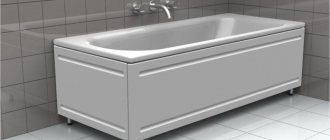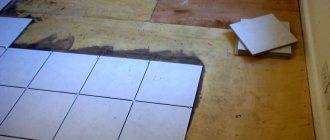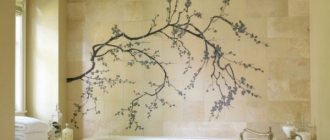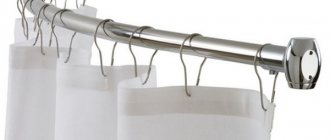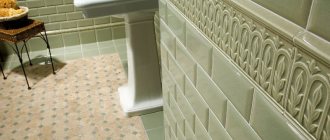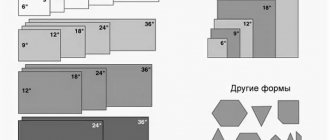Features of using linoleum in the bathroom
It is worth noting that linoleum has never been valued as a floor covering for rooms with constantly high air humidity. None of the existing manufacturers today can boast of a material intended directly for covering floors in plumbing units.
The most problems arise for owners of private houses with wooden floors. Wood is not intended for bathroom conditions, since when exposed to moisture it is irreversibly deformed. Accordingly, the floor covering must be moisture resistant and protect the floors. Based on this, linoleum should be selected solely by characteristics, but not by appearance.
Wall pasting technology
Before gluing linoleum, level the walls.
The technique is similar to laying flooring, only the actions must be performed on vertical planes.
The material is allowed to sit for 12 hours until it reaches the temperature of the room in which the work is being done.
You can stick linoleum to the walls yourself by performing the operations in this order:
- Cleaning of the wall is carried out before the concrete slab. Depressions, cracks, and chips are filled with moisture-resistant solutions and putties. The difference is allowed no more than 2 mm per 1 m of surface. Considering the thickness of the material, it is desirable that it be no more than 1 mm. The plane is checked with a construction water level.
- Impregnation with antibacterial primer 2 times (with a drying break of 4 hours). The primer also increases the adhesive properties of the base.
- The adhesive is evenly applied to the wall with a notched trowel in accordance with its manufacturer's recommendations. The thickness of the layer usually coincides with the same size of the sheet (1 - 1.5 mm), the base temperature is not lower than + 10 ° C, but some mixtures, according to the instructions, are preheated and kept for a certain time between stages of preparation. The teeth on the profile are necessary for the release of air and tight contact along the entire plane of the applied material.
- Linoleum, pre-cut to the required size, is applied to the glue and rolled with a roller. If the usual wallpaper is placed vertically, then this material is rolled out horizontally or cut into squares or fragments in accordance with the pattern applied to them. It is advisable to minimize the number of seams, just like with conventional linoleum. The polymer can be cut well with a regular construction knife. If the work is being performed by the contractor for the first time, then you must first practice making joints on scraps of material so that you do not have to move a large sheet over the solution, disrupting the adhesion with the canvas.
- Sealing the seams is designed to seal the hardened adhesive mixture from moisture and changes in air temperature. The best way is to use a special cord (polyurethane) with hot laying. The seam is filled with a polymer rod, which, when melted, fills all the voids and welds the sheets together. Heat the material with a hair dryer, soldering iron or, in extreme cases, an iron. A beautiful and high-quality seam requires certain practical skills. A less reliable method of sealing joints, but one that can be done with your own hands without the involvement of specialists, is cold welding.
- The final step is to decorate the upper and lower edges of the canvas so that the laid linoleum on the wall acquires an aesthetically noble appearance. For this purpose, borders are selected according to colors (matching, transitional to the ceiling and floor, contrasting for differentiation). If necessary, the edges of the sheets are cut in place to a straight line. To learn how to properly glue linoleum, watch this video:
Operation of the premises begins after the glue polymerization process is completely completed. These deadlines are indicated in the instructions attached to it.
Nuances of purchasing and preparing material
If you have already decided which linoleum is best for your home, then you have already bought it. Before you begin, you should carefully read the instructions that come with the roll materials.
It is important to familiarize yourself with the standard requirements before starting work:
- the material must be adapted to the microclimate of the room, since changes in humidity and temperature changes lead to compression or divergence;
- better coating strength will be achieved if frequent joints between adjacent strips are avoided. The standard roll width is from 2.5 to 4 meters;
- linoleum is not fire-resistant, and therefore it is worth avoiding its fire, since when burning the material emits toxic fumes;
- Before purchasing linoleum, you should carefully measure the room, and also do not be shy and ask for help from managers at a hardware store. Specialists will be able to more accurately think through the amount and type of coating that will be ideal for a room with certain parameters.
Pasting
The task itself is not particularly difficult - you just need to smear the surface with glue and press the fixed panel tightly against it. However, in reality everything can turn out to be much more complicated.
- First you need to clean the walls with special care. If dust or dirt remains on them, the coating will simply not stick well and may eventually move away from the base.
- Next comes the primer's turn. In this case, it is mandatory, since gluing will be carried out over a large area and increasing adhesion is necessary here.
- After this, the pre-cut elements are smeared with special glue and left to sit for a certain period of time - the required time is usually indicated on the packaging of the adhesive composition.
- All that remains is to press the covering tightly against the wall. It is better to do this with an assistant to avoid the appearance of swelling and peeling.
When the required area of the walls is covered, you need to take care of the tightness. The joints, no matter how few they are, are still there and they can let water through. Therefore, the panels are “welded” together. This is done by two methods - by heating a special cord placed in the seam, which melts and connects the pieces, and by gluing. The second method is much easier to use for a non-professional, and the first is better used by those who already have similar experience.
Laying linoleum on a wooden floor
The process of leveling a cement floor has been described many times and will not cause any difficulties for an owner who has the slightest understanding of construction. As for processing floors in a wooden house, it will take more effort and time to create a high-quality base for laying linoleum.
Initially, many wooden buildings are simply not equipped with a bathroom. Owners most often build a kind of plumbing unit in the outbuildings. All they have to do is understand whether it is possible to lay linoleum in the bathroom and how to do it (for more details: “How to lay linoleum on a wooden floor with your own hands”).
In fact, the sequence of actions in this case is very simple:
- the wooden covering must be impregnated with antiseptics, which will preserve the wood in the absence of ventilation due to the tightness of the laid material;
- any unevenness on the surface of the floor beams can lead to deformation of the linoleum, and therefore the floor should be covered with a perfectly flat sheet of chipboard or OSB;
- the linoleum must be allowed to rest for 24 hours, and then it must be glued, not forgetting about the 5-centimeter spacing on the walls (more details: “How long and how long does linoleum rest?”);
- joints between adjacent sheets of material must be hidden. To do this, you can use a hair dryer or Cosmofen glue.
According to residential construction standards, there is a requirement for the floor level in the plumbing unit, and it must be lower than the same surface in other rooms of the house. If such a discrepancy arises, then the risk of accidental spillage of liquid from the bathroom into neighboring rooms can be eliminated by using an inflated threshold that will clamp the linoleum sheet under the door.
If we take into account all the features of wooden floors, we can safely say that linoleum is the cheapest floor covering that resists moisture well and has a long service life. At the same time, such a surface looks aesthetically pleasing, so that it is impossible even to distinguish it from traditional facing materials from a photo or at first glance.
Naturally, for the best design, you need to buy waterproof linoleum with a texture that imitates any of the alternative coatings.
Also, many owners are interested in whether it is possible to lay linoleum in a bathroom that is equipped with its own floor heating system. Naturally, this is permissible, but in this case a special coating should be used, which is appropriately marked, and the documents for this material indicate the maximum temperature level for heating the surface. It is also worth considering that linoleum has poor thermal conductivity and to heat the room you will have to spend a significantly larger amount of energy.
Properties and characteristics
The word "linoleum" is translated as oil-soaked fabric.
The production of such material began in the 1600s, and to this day many new types appear on the market. Oil impregnation was created so that spilled water would not be absorbed, but would remain on the surface. Therefore, linoleum is a good replacement for tiles, and relatively cheap.
Wall linoleum is made from polyurethane raw materials. Polyurethane has the ability to bend and stretch well, so the coating is well suited for gluing to curved surfaces with protrusions.
For bathrooms, single-layer linoleum without a felt base is used. Since water absorption will be much lower, the material will last for many years.
Useful and unusual ideas for a summer house made from old unwanted linoleum
In addition, the coating is easy to clean, even without the use of special chemicals.
Owner reviews
Many owners who have already chosen linoleum as a flooring for plumbing in a wooden house have left reviews on the Internet.
Naturally, there are many opinions and each person has formed his own view on this issue, but most of them agree on a number of points:
- the material is the cheapest among alternative coatings that match the characteristics;
- the installation process is very simple: you just need to stock up on the material itself, a high-quality adhesive mixture and an algorithm of actions, from which you should not deviate, since this is fraught with consequences when using the floors;
- The service life reaches 10 years, and can last longer with careful use. At the same time, the coating retains its tightness and practically does not lose its appearance. Types of coating with texture applied over the entire thickness are very practical. Even with uneven abrasions, in the photo and upon visual inspection they will look like new;
- to avoid injuries, you should purchase a coating that is rough or treated with a special anti-slip compound;
- In the absence of underfloor heating, linoleum can be cold, so you should purchase types that store heat better and can be used without a heating system.
Bottom line
From all of the above, we can conclude that the reliability of the coating cannot be guaranteed if you deviate from a clear algorithm of actions when laying linoleum. This material should be used in cases where it is not possible to lay tiles, porcelain stoneware, parquet and other coverings. If certain difficulties arise with laying linoleum, you should seek help from professionals who will take care of all stages, from purchasing building materials to checking the finished coating.
Advantages and disadvantages
Like any other materials, linoleum has its advantages and disadvantages.
Pros:
- Easy to install . The material lends itself well to installation on different surfaces.
- Large canvas . There will be no need to cover the seams, since you can buy wide linoleum that will immediately cover the entire wall.
- Low price . Compared to floor slabs, you can save a lot on this material.
- Moisture resistance . The material does not allow a single drop of water to pass through. But only on the condition that a large layer of felt was not used in the lining.
- Hygienic . Molds and other bacteria do not form, as the surface is easy to clean.
Minuses:
- Small selection in stores. Unfortunately, many small construction networks have not even heard of wall linoleum.
- Color spectrum . Most of the canvases have the appearance of wood or parquet, which does not look so organic for a bathroom.
Disadvantages of linoleum
Of course, linoleum is not an ideal material, since it is also not without its drawbacks. Moreover, some of them can be corrected, but some will have to be accepted. So, the disadvantages of finishing:
- Moisture permeability. The reverse side of many types of linoleum is a fleecy or spongy base that not only quickly absorbs moisture, but also retains it for a very long time - it is because of this that the opinion about the low moisture resistance of the material has taken root in the minds of many people. But here two nuances need to be noted. Firstly, the “sponge” effect is not characteristic of all types of linoleum, but mainly the cheapest ones, so do not skimp on the product and buy finishing only with a quality certificate and only from trusted manufacturers. Secondly, if the cladding is installed correctly and the new floors are carefully sealed, moisture will not flow to their underside.
High-quality linoleum will retain its properties for a long time
- Abrasion. Low wear resistance is a problem with low-price linoleum. Indeed, after a few years, such a finish may not only lose its aesthetic appearance, but even become scuffed. There is only one way to protect yourself from such negative consequences - to buy material of a medium or high price category.
- Slippery. When water gets on linoleum, it, like almost any flooring material, becomes slippery. Ordinary bath mats will help correct this disadvantage.
Advice. If your financial capabilities allow, buy linoleum with a special anti-slip coating.
Material evaluation
Before purchasing linoleum for your bathroom, you should get acquainted with the advantages of this material, as well as evaluate the negative aspects of its use. The most obvious advantages are the affordable price and ease of installation. In addition, the following advantages can be highlighted:
- Moisture resistant. The presence of a linoleum coating provides additional waterproofing.
- Easy care. Linoleum is very easy to keep clean.
- Variety of patterns. Linoleum is available in a huge range; you can choose coatings that imitate tiles, wood, stone, etc.
- Additional thermal insulation. Ceramic tiles are almost always cold; stepping on linoleum flooring is much more pleasant.
But the coating also has significant disadvantages. This is, first of all, insufficient strength. Not every type of linoleum can withstand the weight of heavy plumbing fixtures. And dents will quickly appear under the legs of the bathtub. In addition, wet linoleum floors are extremely slippery, which can lead to injury.
Advice! There are types of linoleum with anti-slip coating on sale, but they are much more expensive than usual.
Differences between wall and floor materials
In terms of external indicators, the wall covering is practically no different from linoleum for the floor. The only difference is the absence of a base, as a result of which the material becomes thinner, lighter in weight and more flexible. Accordingly, due to this, the price of this product decreases.
It is very light, and thanks to this you can glue linoleum to the wall instead of wallpaper.
Another coverage option
Positive traits
Among the advantages, I would like to note the following indicators:
- Resistant to mold and mildew. This quality of the material makes it possible to use it in rooms that require sterility - for example, pharmacies, laboratories or operating rooms.
- Caring for the surface will not require much effort. To do this, it is enough to carry out wet cleaning using a soap solution. In case of more significant contamination, linoleum can withstand treatment with chemical agents.
- Has good strength. Virtually not subject to mechanical damage.
- Aesthetic appearance. High-quality pasting of wall surfaces will give a special harmonious look and will not leave household members and friends indifferent.
- Linoleum is quite easy to install. This kind of work can be done even by a person with no experience.
- The material is durable and can last for many years.
- Non-toxic and does not emit harmful impurities.
- When laid on walls in a room with high humidity, the product remains unchanged and does not change in size under the influence of external factors.
- The material is dense and does not absorb moisture.
- Handles chemicals.
Wall design option
Types of coverage
Modern linoleum is made from various materials on natural and synthetic bases.
According to the degree of wear resistance, it is divided into several classes:
• 21-23, or household (for residential premises);
• 31-34, or semi-commercial (for public places);
• 41-43, or commercial (for the industrial sector).
Depending on the structure, linoleum can be homogeneous or heterogeneous:
Homogeneous. It is a material with a uniform texture, thickness from 1.5 to 3 mm. It has a simple color, often without a pattern. It is resistant to abrasion and retains its appearance for a long time.
Heterogeneous. Consists of several layers. Its thickness is from 2 to 6 mm. Available in different colors, designs and patterns.

